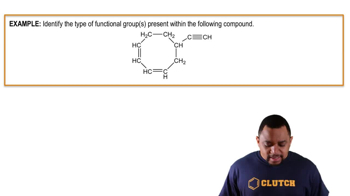Write structural formulas for compounds that meet the following descriptions:
d. A disubstituted benzene with a total of 8 carbons (three possibilities)
 Verified step by step guidance
Verified step by step guidance Verified video answer for a similar problem:
Verified video answer for a similar problem:



 :30m
:30mMaster Monosubstituted Benzene Concept 1 with a bite sized video explanation from Jules
Start learning